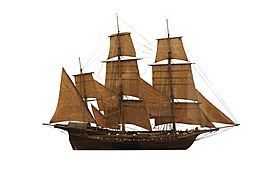Capture of HMS St. Fermin facts for kids
Quick facts for kids Capture of HMS St Fermin |
|||||||
|---|---|---|---|---|---|---|---|
| Part of American Revolutionary War | |||||||
 Squared-rigged xebec of the 1780-1815 period |
|||||||
|
|||||||
| Belligerents | |||||||
| Commanders and leaders | |||||||
| Strength | |||||||
| 2 xebecs | 1 sloop-of-war | ||||||
| Casualties and losses | |||||||
| None | 138 prisoners 1 sloop-of-war captured |
||||||
The Capture of HMS St Fermin was a sea battle that happened near Málaga, Spain, on April 4, 1781. This event was part of the American Revolutionary War. During this battle, two Spanish ships, called xebecs, captured a British warship. The British ship was a sloop-of-war named HMS St Fermin.
Contents
Why This Battle Happened
The American Revolutionary War Context
The American Revolutionary War (1775-1783) was a big conflict. It involved Great Britain and its American colonies. Other European countries, like Spain and France, also joined the war. They supported the American colonists. Spain wanted to weaken Great Britain.
Gibraltar Under Siege
One important place during this war was Gibraltar. Gibraltar is a British territory located at the southern tip of Spain. The Spanish army and navy had surrounded Gibraltar. They were trying to capture it from the British. This was known as the Great Siege of Gibraltar.
How St Fermin Became a British Ship
In late 1779, a large British fleet sailed from Great Britain. It was led by Admiral Sir George Brydges Rodney. One of his main goals was to bring supplies to Gibraltar. On January 8, 1780, Admiral Rodney's fleet found a Spanish convoy. A convoy is a group of ships traveling together. He captured all the Spanish ships. One of these captured ships was a merchant ship named San Fermín. It had 16 guns. The British took San Fermín to Gibraltar. They made it a British warship. They renamed it HMS St Fermin. Commander Jonathan Faulknor became its captain. From then on, HMS St Fermin helped defend Gibraltar.
The Capture of HMS St Fermin
Leaving Gibraltar
On the evening of April 3, 1781, HMS St Fermin left Gibraltar. Its mission was to deliver important messages to Menorca. Menorca was another island where British forces were stationed. The British used fast ships to get past the Spanish blockade. This blockade was an attempt to stop ships from entering or leaving.
The Spanish Chase
HMS St Fermin sailed safely through the Strait of Gibraltar. However, the Spanish navy had lookouts in the area. These lookouts could spot British ships. From a Spanish naval station, two Spanish Navy ships began to chase St Fermin. These ships were San Antonio and San Luis. They were both xebecs. A xebec is a type of sailing ship. It has both square sails and triangular sails.
- San Antonio had 26 guns. It was commanded by Captain José Herrera-Dávila.
- San Luis had 24 guns. It was commanded by Lieutenant Federico Gravina.
Both Spanish ships had over 200 men on board.
The Night Battle
That night, Commander Faulknor saw the two Spanish ships coming closer. He tried his best to escape. At 11 o'clock at night, the Spanish ships lost sight of St Fermin. But only half an hour later, they spotted it again. By 4 o'clock in the morning, the Spanish ships were very close. They started firing their chase guns. These are guns placed at the front of a ship. They are used when chasing another ship. HMS St Fermin fired back with its stern guns. These are guns at the back of the ship.
Captain Herrera-Dávila's ship, San Antonio, got very close to St Fermin. It fired several shots. This was enough for Commander Faulknor to surrender. Surrendering means giving up the fight. The battle happened about 10 miles off the coast of Málaga.
What Happened After
The Captured Ship and Crew
The British ship, HMS St Fermin, had 138 crew members. All of them were taken as prisoners. A Spanish group, led by Lieutenant Miguel Pedrueca, took charge of the prisoners. The Spanish then took the captured ship to Cartagena.
After its capture, the ship was added to the Spanish Navy. It was renamed San Fermín again. It served as a 16-gun ship. However, it was removed from service in 1785.

